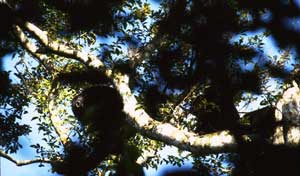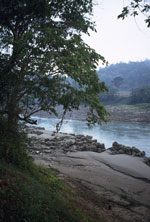![]()
|
(The scene on the image link that you clicked to arrive is essentially from camp, looking downriver and toward Guatemala from Mexico. Truly, I have been in some very remote spots, but really nothing compares to this. The sounds of the jungle as evening ensues are unique and powerful; sleeping among the fireflies and monkeys is unforgettable!)
|
||||
|
"THE COMING OF DARKNESS" |
||||
|
As we walk briskly back to our jungle camp along the Usumacinta River, a group of fascinating sounds begin to emerge from the rain forest canopy. During the day visitors are greeted with the remarkable songs of numerous tropical birds: the Keel-Billed Toucan, Blue-Crowned Motmot, Violaceous Trogon, Mangrove Vireo, countless parrots, dozens of hummingbirds -- all (and many more) are present and accounted for. As evening approaches the birds subside, but the insect sounds increase to a crescendo. The humming and buzzing seems almost deafening (and in fact is rather bothersome to friendly conversation). We are treated to a wonderful village/"typico" (of course!) dinner of chicken, rice and black beans. The elderwoman cook and guides dine apart (separate table in the same small hut) from the "guests." Villagers and "tourons," two Italians, two Dutch, two Americans, and many conversations -- now merge into one discussion concerning the local fisherman's new tool -- a battery-powered flashlight. With this device he can locate fish at night, and then "catch" them with his proudly-displayed (if roughly-hewn) prehistoric looking forked wooden spear. Questions are asked and answered -- albeit in a variety of languages -- but this did not really matter. What was being discussed was understood by all.
After dinner Cheryl and I decide to walk back through the ruins, just a few kilometers away from our airstrip camp. We take a side trail that we had previously familiarized ourselves with, and begin to follow "wild" sounds up a hill and therefore into the jungle canopy. The voices we are following are the unmistakable roars of the sentinels of this "neck" of the rain forest; the primal utterances of "mano congo" -- the small great ape of Mesoamerica -- the Howler Monkey. At dusk and dawn various groups call out to one another from differing locations within the jungle. Their sound is like no other; starting with grunt-barks, the resonance (steadily louder) becomes a roar, not unlike a lion's statement, perhaps as heard through a metal pipe or tunnel. As a human approaches the sound becomes almost deafening. Placing oneself directly underneath the monkeys allows the unwitting individual to be pelted by fruit, and then urinated upon.
After some time, we join the rest of the group in the plaza of the ruins and when we (the human visitors) reappear from behind adjacent structures, the monkeys begin roaring again. It is a troupe from the giant Ceiba tree on the edge of the excavation. The apes seem to be guarding this area of the forest from our intrusion. We all spend the final available daylight enjoying the each other's and nature's presence in the beautiful backcountry of southern Chiapas, Mexico.
It's getting quite dark, so we now hasten to our encampment and retire to the tents. These are two-person "pup" tents with canvas skins doubling as rainflys. I struggle to secure the dwelling (a must in this jungle setting) as Francisco, our head guide, advises to entirely zip up all openings. There is no insect netting, hence the resultant heat inside is much like a steam bath. Francisco has lined the floor with a very thin mattress and a blanket (for what?). The shelter must be 100+ degrees inside. We lay down, with full knowledge that actual sleep may not be on the agenda this evening. As we lay motionless, dozing off to the Howler Monkeys from Guatemala challenging their cousins from Mexico, the wind begins to blow. How curious, I think, for the tropical rain forest. Then it comes. Rain. Rain like you've never experienced. Driving rain, vertical rain, horizontal rain, glorious rain, cooling rain. Constant lightning strikes. I poke outside. The air is cooler. It's also almost light out, as the lightning is so constant that the airstrip and village are clearly visible. The Europeans retreat to Francisco's tent, located under a shelter. (I am left to ponder where Francisco slept.) We remain, actually using the previously discarded blanket. These canvas tents really are stable (heavy!) in the wind and rain. No leaking. We drift off to a comfortable sleep.
Near dawn the rain-drenched jungle is utterly, almost unwittingly quiet. Then the sounds start anew; a crescendo of joyous monkeys, birds, insects and life -- after a fulfilling rain -- celebrating the dawn of yet another day in the primeval lowland rain forest.
|
||||
All design and content copyright Greiner/Price, all rights reserved. |




